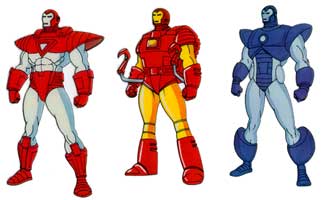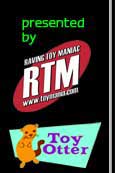
In July of 1994, Toy
Biz announced a new action figure line: Iron Man. Set to coincide
with the new animated series, the figure line was a surprise to many
since it was not unveiled at Toy Fair. But the amazing success of
Toy Biz's Spider-Man line and the simultaneous cartoon launch led
them to capitalize on the Marvel license with two more toy/cartoon
launches: Fantastic Four and Iron Man. These would collectively be
known as the Marvel Power Hour. The 5" figures were the heart and
soul of the entire line. What drove this line was a new concept for
Toy Biz: interchangeable vac-metallized armor. The figures were basically
split into two types: Armored or Unarmored. Of the armored figures
(mainly Iron Man variants) the separate armor pieces were removable.
Given the uniformity of design, most of the armor pieces were interchangeable
and could be used with other armored figures.
Finally realizing
that they had a property that could capitalize on the Batman
concept of multiple versions of the main character, Toy Biz made sure
that the Iron Man line relied heavily on variants of the title character.
It seemed like a natural fit given that Iron Man actually had worn
many of the armors. It just made sense that he would have multiple
versions (unlike some of the nearly nonsensical Batman variations).
However, the Iron Man character is not quite as archetypal as Batman
and the concept ultimately failed after four series. Another factor
that had to have helped along the line's demise is the fact that having
multiple armor pieces cost more for tooling and production that a
normal figure, and vac-metallization is somewhat expensive anyway.
Toy Biz's profit margin for this line was most likely fairly lower
than that of Spider-Man or X-Men.

Canceled fifth assortment
But these were
not the only factors in the line's hasty departure: there were some
production problems with the Iron Man line. Armor pieces didn't always
fit properly. And there were often problems with the vac-metallization
of the little armor pieces such as chipping and loss of color resulting
in many sloppy looking figures. But even despite these minor problems,
Iron Man had an almost immediate cult status among collectors. Either
you loved them or you hated them.
The card backs
were similar for each series, but each had it's own unique artwork
of Iron Man on it (see the individual series pages for examples of
cardbacks from each series). The series are easily distinguishable
by the picture on the cardback: Regular Armor Iron Man (Series I),
Stealth Armor Iron Man (Series II), Arctic Armor Iron Man (Series
III), and Samurai Armor Iron Man (Series IV). Many of the armors in
the line (and the cartoon series) were based on outfits Iron Man wore
throughout the comic book's long history. Unfortunately, the supporting
cast relied more on the short-lived comic ForceWorks, which has recently
debuted, than on a more appropriate group such as the Avengers. If
such a tradeoff had been made, maybe the line would still be around
today. Of course, we never even got one lousy "Classic"
Iron Man from before the 1970s, so maybe that type of thinking is
what killed the line.
Fortunately for
collectors, most figures were plentiful while they lasted. Future
collectors may have problems finding mint, loose specimens given the
number of small armor accessories. It is hoped that this guide will
serve as an archive for identifying these figures for newer collectors.
With information on defunct lines becoming increasing difficult to
find, it would be a shame to let this line slip into oblivion without
some monument.
If you have
any info on other items or just feel the need to make a correction,
write me here.
Series 1 | Series
2 | Series 3 | Series
4 | Series 5 | Other
Figures | Armor
| Misc | Main | RTM Archives




